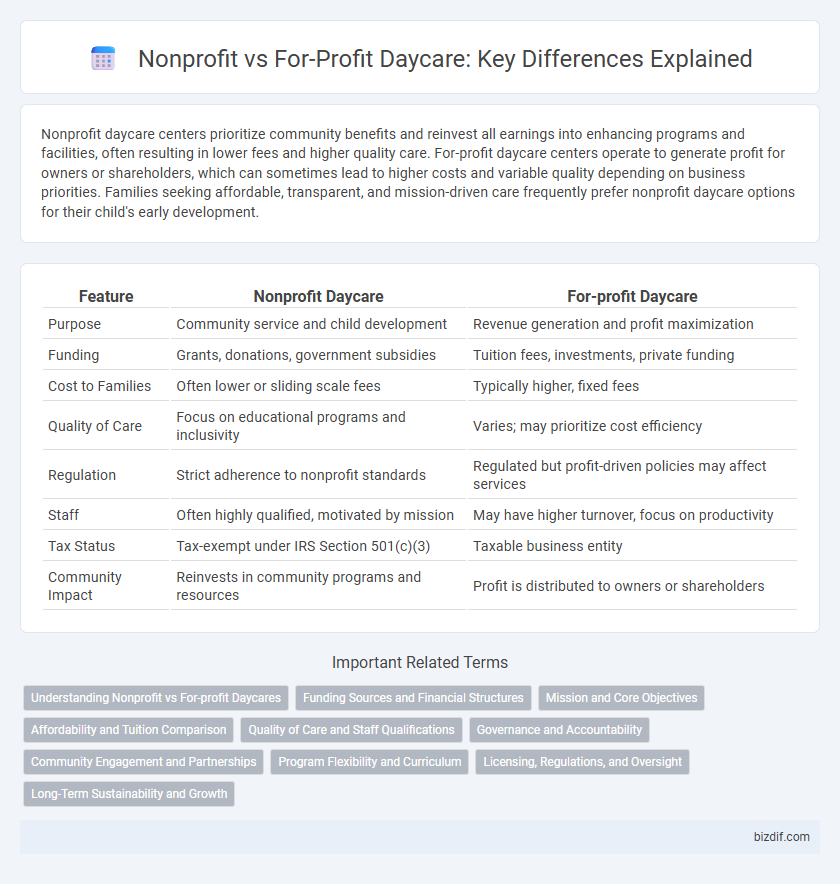Nonprofit daycare centers prioritize community benefits and reinvest all earnings into enhancing programs and facilities, often resulting in lower fees and higher quality care. For-profit daycare centers operate to generate profit for owners or shareholders, which can sometimes lead to higher costs and variable quality depending on business priorities. Families seeking affordable, transparent, and mission-driven care frequently prefer nonprofit daycare options for their child's early development.
Table of Comparison
| Feature | Nonprofit Daycare | For-profit Daycare |
|---|---|---|
| Purpose | Community service and child development | Revenue generation and profit maximization |
| Funding | Grants, donations, government subsidies | Tuition fees, investments, private funding |
| Cost to Families | Often lower or sliding scale fees | Typically higher, fixed fees |
| Quality of Care | Focus on educational programs and inclusivity | Varies; may prioritize cost efficiency |
| Regulation | Strict adherence to nonprofit standards | Regulated but profit-driven policies may affect services |
| Staff | Often highly qualified, motivated by mission | May have higher turnover, focus on productivity |
| Tax Status | Tax-exempt under IRS Section 501(c)(3) | Taxable business entity |
| Community Impact | Reinvests in community programs and resources | Profit is distributed to owners or shareholders |
Understanding Nonprofit vs For-profit Daycares
Nonprofit daycares reinvest surplus revenue into improving educational programs, staff training, and facility upgrades, prioritizing child development over profits. For-profit daycares operate as businesses aiming to generate profit for owners or shareholders, potentially leading to cost-cutting measures that impact quality. Research indicates nonprofit daycares often maintain higher standards of care, better staff-to-child ratios, and more comprehensive early childhood education curricula compared to many for-profit centers.
Funding Sources and Financial Structures
Nonprofit daycare centers primarily depend on government grants, charitable donations, and fundraising events to support their operations, which allows them to reinvest surplus funds into improving educational programs and facilities. For-profit daycare centers rely on tuition fees and private investments, focusing on profitability and expanding service offerings to attract more clients. These differing financial structures influence pricing models, quality of care, and accessibility for families seeking early childhood education.
Mission and Core Objectives
Nonprofit daycares prioritize community welfare and child development by reinvesting all earnings into enhancing educational programs, staff training, and facility improvements. For-profit daycares focus on generating revenue while balancing quality care and operational efficiency to satisfy shareholders or owners. The core objective of nonprofit centers is to provide affordable, high-quality care driven by mission, whereas for-profit centers emphasize profitability alongside childcare services.
Affordability and Tuition Comparison
Nonprofit daycares often offer more affordable tuition rates due to their focus on community service rather than profit generation, resulting in lower fees and potential access to subsidies or sliding scale pricing. For-profit daycares typically charge higher tuition to cover operating costs and generate income, which can limit affordability for some families. Comparing costs, nonprofit daycares frequently provide better value for low- and middle-income households seeking quality early childhood education.
Quality of Care and Staff Qualifications
Nonprofit daycares typically prioritize quality of care by reinvesting surplus funds into staff training, enhanced curriculum, and child development resources, resulting in higher staff qualifications and lower child-to-teacher ratios. For-profit daycares often face pressure to maximize profit margins, which can limit investment in advanced staff certifications and ongoing professional development. Studies indicate children in nonprofit daycare settings benefit from more individualized attention and experienced caregivers, contributing positively to cognitive and emotional growth.
Governance and Accountability
Nonprofit daycare centers are governed by a board of directors focused on community service and transparency, ensuring funds are reinvested to enhance child care quality and accessibility. For-profit daycare centers operate under private ownership or shareholders, prioritizing financial returns while meeting regulatory standards set by local authorities. Both models maintain accountability through licensing, but nonprofits often emphasize stakeholder involvement and public trust in their governance structures.
Community Engagement and Partnerships
Nonprofit daycare centers often prioritize community engagement by collaborating with local organizations, schools, and health services to provide comprehensive support for children and families. These partnerships enhance resource sharing, offer educational programs, and promote social services that directly benefit the community. For-profit daycares typically focus on business growth and may engage in partnerships that drive marketing or operational efficiency rather than broad community involvement.
Program Flexibility and Curriculum
Nonprofit daycare centers often emphasize program flexibility tailored to community needs, offering adaptable schedules and inclusive curricula that prioritize child development and learning outcomes. For-profit daycare facilities typically provide structured programs with standardized curricula designed to meet market demands and parental expectations, sometimes limiting customization. The focus on program flexibility in nonprofit centers supports diverse educational approaches, whereas for-profit centers balance curriculum quality with operational efficiency.
Licensing, Regulations, and Oversight
Nonprofit daycare centers often operate under stricter licensing requirements and regulations to ensure child safety and educational quality, frequently overseen by state or local government agencies with additional accountability to their boards. For-profit daycare facilities must comply with the same basic state licensing standards but may face less rigorous oversight regarding financial transparency and educational programming. Both types are required to meet health, safety, and staffing regulations, but nonprofits typically receive more frequent inspections and have greater obligations for reporting outcomes to stakeholders.
Long-Term Sustainability and Growth
Nonprofit daycare centers prioritize community reinvestment and eligibility for grants, enhancing long-term sustainability through steady funding sources and public trust. For-profit daycare centers focus on maximizing revenue and scalability, which can drive rapid growth but may face challenges in maintaining affordability and consistent quality over time. Long-term success in either model depends on balancing financial health with quality care and adapting to evolving market demands.
Nonprofit Daycare vs For-profit Daycare Infographic

 bizdif.com
bizdif.com